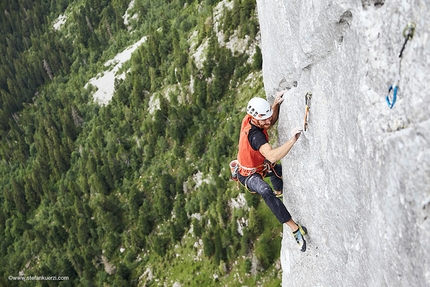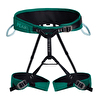Big wall explored in Valle de la Plata, Patagonia, by Siebe Vanhee, Max Didier, Austin & Ian Siadak

 1 / 4
1 / 4 Austin Siadak
Austin Siadak
Max Didier (CL), Austin Siadak (USA) and Ian Siadak (USA) and I decided to spend February 2020 in the jungle and on unclimbed granite. We had met last year in El Chaltén (Patagonia) and our ambitious plan was to explore some new granite walls in the Palena Province in Northern Chile. Originally, Max had scouted some unknown walls on Google Earth in a valley called Valle Alerce. We were motivated and prepared for the full big wall adventure, because that’s exactly what we were searching for; an unclimbed big wall to climb and spend some time with friends on our portaledges. Before fully committing though we invested a day scouting the valley, but while Valle Alerce was indeed wild and had lots of rock, it just didn’t awaken the big wall vibes in us; too much jungle and maybe just not vertical enough. A little disappointed but with a plan B in the back of our minds we decided to return to civilisation and consider our options.
Close to Valle Alerce lies another valley called Valle de la Plata which leads to a big wall called Serania Avalancha. This wall had previously been climbed by Mariana Gallego, Martin Molina and Luis Molina in 2007 and by Silvia Vidal who in 2012 established Espiadimonis (A4/6b, 1500m). Despite their ascents we couldn’t find much information about the approach, the wall and the area. Nevertheless we decided to commit to Valle de la Plata and have a look at this mythical Serrania Avalancha wall.
Reading Silvia’s reports, we knew the approach was only 8 kilometers. Short but difficult because of the pure jungle and wild river hiking. This information we had was confirmed rapidly. After only 1 hour we bumped into dense jungle and a steep river with lots of waterfalls; walking along the riverbed proved impossible. A further five challenging days followed, during which we swung our Bear Grylls machetes, crawled on hands and knees, waded through the river - at times deep - often with strong currents. The objective of climbing during that 7-day weather window vanished as we conquered more and more bamboo and river crossings. Merely reaching Laguna de la Plata, the huge lake at the base of the wall, sudenly seemed like a great objective.
Six days into our trip we finally reached the laguna. Much to our surprise we didn’t see only the famous Serrania Avalancha wall rising out of the lake: opposite Serrania we saw a beautiful white wall full of obvious crack systems. Not only did this wall looked more appealing, it also looked drier and less likely to transform into a multitude of raging waterfalls when the rains would start. Because bad weather had been forecast and with time running out due to the long approach, we decided to go for the smaller but very appealing "opposite" wall.
The first 3 of our 8 days camping below the wall were spent climbing and reaching the summit. Fixed ropes were used make progress before we returned to basecamp. We baptised the peak and wall Pared de la Plata, while we called our route Bailando con la Lluvia (Dancing with the rain). This name refers to the difficulty we experienced climbing inbetween the rain curtains that transformed the walls into raging waterfalls. We sneaked into every little nook and cranny to reach that summit on a very grey and unstable day, during which threatening clouds and small showers were upon us constantly.
During the descent we decided to leave static ropes fixed in order to return to pitch 8, the top of an amazing pillar jammed into a big dihedral. During our first ascent the obvious line on pitches 10 to 12 didn’t go free because of the wet, mud and moss in the cracks. Descending we spotted a cleaner variation to the left and this motivated us to come back and try to make it an all free ascent. One day of rain and waterfalls later a real 5-day weather window showed up. This was our chance, this is what we had come for. We packed our well-prepared big wall kit and moved our camp up onto the wall, to the top of what we'd dubbed the Puerto Pillar.
The next day and a half day were spent free climbing this variation. Just one hand-drilled bolt was necessary in order to traverse out left into another corner system on pitch 10. This was the beautiful free climbing we were looking for. Bailando con la Lluvia therefore has an original aid version (7a / A2, 16 pitches, 700m) and a free variation to the left (7a, 16 pitches, 700m). This first ascent was climbed team-free over several days.
The two nights on the wall were for sure the highpoint of the trip, the contrast between the heavy rainy days and stable weather made us savour these wild surroundings even more! Unfortunately though we couldn’t enjoy the weather any longer. Because the hike out of the valley would prove impossible with rain and rising rivers we had to take advantage of the last two good days and start to hike out, immediately after our descent to basecamp. During the next two days, knowing the river crossings, the jungle path and every single trick in the book, we managed to transport all our loads back down to Rio Avalancha and cross this on foot to return to our starting point.
This was a very committing expedition that I am happy to have shared with friends with whom I feel at ease and safe. These are key ingredients for becoming a solid team and for reaching solid objectives, which we did. Thank you, Max, Austin and Ian, for all the good vibes, communication and motivation.
Many thanks to all the locals in Chaíten and Puerto Cárdenas for helping us with logistics. Big thanks to local gaucho Pierre Angelo who helped us cross Rio Avalancha by horse on our first day. And thanks also to Rolando Garibotti for the accurate weather report, crucial for that threatening summit day!
Siebe Vanhee, 5 March 2020
Links: FB Siebe Vanhee, www.siebevanhee.be, La Sportiva, Petzl, The North Face, www.austinsiadak.com
Note: Pared de la Plata was first attempted in 2014 by Tola Señoret, Juan Señoret, Mike Sanchez and Sebastian Schmidt but although they climbed fourteen pitches, retreating just below of the end of the difficulties, the wall remained unclimbed. Siebe Vanhee, Max Didier, Austin Siadak and Ian Siadak Bailando con la Lluvia shares parts of two pitches of this 2014 attempt.



 Copia link
Copia link




























